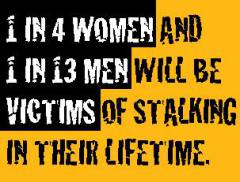Stalking
What is stalking?
Stalking is a pattern of repeated and unwanted attention, harassment, contact, or any other course of conduct directed at a specific person that would cause a reasonable person to feel fear.
Stalking can include the following:
- Repeated, unwanted, intrusive, and frightening communications from the perpetrator by phone, mail, and/or email.
- Repeatedly leaving or sending victim unwanted items, presents, or flowers.
- Following or laying in wait for the victim at places such as home, school, work, or recreation place.
- Making direct or indirect threats to harm the victim, the victim's children, relatives, friends, or pets.
- Damaging or threatening to damage the victim's property.
- Harassing victim through the internet.
- Posting information or spreading rumors about the victim on the internet, in a public place, or by word of mouth.
- Obtaining personal information about the victim by accessing public records, using internet search services, hiring private investigators, going through the victim's garbage, following the victim, contacting victim's friends, family work, or neighbors, etc.
If you feel like you are in any danger or feel like you are a victim of stalking visit the Stalking Resource Center at http://www.victimsofcrime.org/our-programs/stalking-resource-center
What is cyberstalking?
Cyberstalking is the use of the Internet, email or other electronic communications to stalk, and generally refers to a pattern of threatening or malicious behaviors. Cyberstalking may be considered the most dangerous of the three types of Internet harassment, based on a posing credible threat of harm. Sanctions range from misdemeanors to felonies.
Some examples of tactics a cyberstalker may use include:
- Sending manipulative, threatening, lewd or harassing emails from an assortment of email accounts.
- Hacking into a victim’s online accounts (such as banking or email) and changing the victim’s settings and passwords.
- Creating false online accounts on social networking and dating sites, impersonating the victim or attempting to establish contact with the victim by using a false persona.
- Posting messages to online bulletin boards and discussion groups with the victim’s personal information, such as home address, phone number or Social Security number. Posts may also be lewd or controversial – and result in the victim receiving numerous emails, calls or visits from people who read the post online.
- Signing up for numerous online mailing lists and services using a victim’s name and email address.
Cyberstalking is difficult to combat because the stalker could be in another state or sitting three cubicles away from the victim. In the anonymous world of the Internet, it is difficult to verify a stalker’s identity, collect the necessary evidence for an arrest and then trace the cyberstalker to a physical location.
For more information about cyberstalking feel free to call the Seven Dancers Coalition or visit the following websites:




